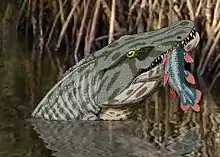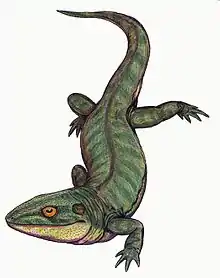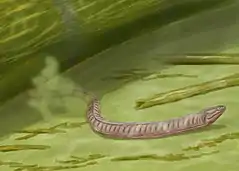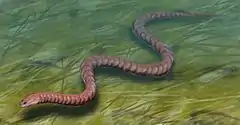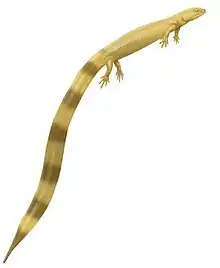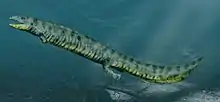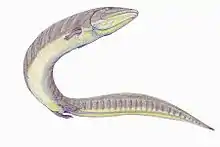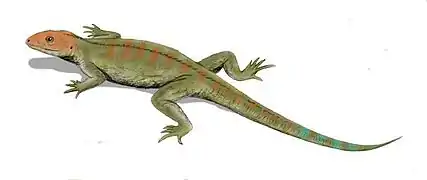Bashkirian
The Bashkirian is in the ICS geologic timescale the lowest stage or oldest age of the Pennsylvanian. The Bashkirian age lasted from 323.2 to 315.2 Ma,[2] is preceded by the Serpukhovian and is followed by the Moscovian.
| Bashkirian | |
|---|---|
| 323.2 ± 0.4 – 315.2 ± 0.2 Ma | |
| Chronology | |
Key events in the Carboniferous -360 — – -355 — – -350 — – -345 — – -340 — – -335 — – -330 — – -325 — – -320 — – -315 — – -310 — – -305 — – -300 — – Key events of the Carboniferous Period Axis scale: millions of years ago | |
| Etymology | |
| Name formality | Formal |
| Usage information | |
| Celestial body | Earth |
| Regional usage | Global (ICS) |
| Time scale(s) used | ICS Time Scale |
| Definition | |
| Chronological unit | Age |
| Stratigraphic unit | Stage |
| Time span formality | Formal |
| Lower boundary definition | FAD of the Conodont Declinognathodus nodiliferus |
| Lower boundary GSSP | Arrow Canyon, Nevada, USA 36.7333°N 114.7778°W |
| GSSP ratified | 1996[1] |
| Upper boundary definition | Not formally defined |
| Upper boundary definition candidates | FAD of the Conodont Idiognathoides postsulcatus or Declinognathodus donetzianus |
| Upper boundary GSSP candidate section(s) |
|
The Bashkirian overlaps with the upper part of the Namurian and lower part of the Westphalian stages from regional European stratigraphy. It also overlaps with the North American Morrowan and Atokan stages and the Chinese Luosuan and lower Huashibanian stages.[3]
Name and definition
The Bashkirian was named after Bashkiria, the then Russian name of the republic of Bashkortostan in the southern Ural Mountains of Russia, home of the Bashkir people. The stage was introduced by Russian stratigrapher Sofia Semikhatova in 1934.
The base of the Bashkirian is at the first appearance of conodont species Declinognathodus noduliferus. The top of the stage (the base of the Moscovian) is at the first appearance of the conodonts Declinognathodus donetzianus or Idiognathoides postsulcatus,[4] or at the first appearance of fusulinid Aljutovella aljutovica.[5] The GSSP (type location for the base of a stage) for the Bashkirian is in the Battleship Wash Formation at Arrow Canyon, Nevada.[6]
Subdivision
The Bashkirian contains six biozones based on conodont index fossils:
- Neognathodus atokaensis Zone
- Declinognathodus marginodosus Zone
- Idiognathodus sinuosus Zone
- Neognathodus askynensis Zone
- Idiognathoides sinuatus Zone
- Declinognathodus noduliferus Zone
Bashkirian life
Arthropods
| Arthropoda of the Bashkirian | ||||
|---|---|---|---|---|
| Taxa | Presence | Location | Description | Images |
| Pennsylvanian | Scotland and northeastern North America | A 2 m (6.6 ft) long millipede |
| |
Cartilaginous fishes
| Chondrichthyes of the Bashkirian | ||||
|---|---|---|---|---|
| Taxa | Presence | Location | Description | Images |
| Carboniferous to Cisuralian | Belgium | A eugeneodontid holocephalian |
| |
|
Pennsylvanian | Kentucky, Ohio, Nebraska, Oklahoma, United States | A symmoriid holocephalian | |
| Carboniferous to Cisuralian | England | A eugeneodontid holocephalian | ||
| Carboniferous to Lopingian | Ohio, Illinois, United States; England | a petalodontiform holocephalian | ||
|
Carboniferous to Cisuralian | Germany | A xenacanthidan elasmobranch | |
| Carboniferous to Cisuralian | Scotland, Wales, Ireland | A xenacanthidan elasmobranch | ||
Coelacanths
| Actinistia of the Bashkirian | ||||
|---|---|---|---|---|
| Taxa | Presence | Location | Description | Images |
| Bear Gulch Limestone, Montana, USA | A genus of actinistian fish in the family Hadronectoridae, distant relatives to coelacanths. |
| ||
Amphibians
Tetrapodomorphs
| Tetrapodomorphs of the Bashkirian | ||||
|---|---|---|---|---|
| Taxa | Presence | Location | Description | Images |
|
British Isles | A genus of basal amphibians in the family Baphetidae. | ||
Temnospondyls
| Temnospondyli of the Bashkirian | ||||
|---|---|---|---|---|
| Taxa | Presence | Location | Description | Images |
| Nova Scotia, Canada;
Jarrow coal mines, Ireland |
Dendrerpeton is a genus of temnospondyl amphibians. |
| ||
| Jarrow coal mines, Ireland | A genus of edopoid temnospondyl within the family Cochleosauridae. | |||
Lepospondyls
| Lepospondyli of the Bashkirian | ||||
|---|---|---|---|---|
| Taxa | Presence | Location | Description | Images |
| Bashkirian | Scotland | An order of rare elongated basal lepospondyls or stem-tetrapods related to Colosteids, that had robust skulls, large eyes and no limbs. |
| |
| Jarrow coal mines, Ireland | A genus of nectridean salamander-like amphibian, a relative of Diplocaulus. | |||
| Nova Scotia, Canada | A genus of gymnarthrid microsaur. | |||
| Jarrow coal mines, Ireland | A genus of nectridean amphibian in the family Urocordylidae. | |||
| Jarrow coal mines, Ireland | A genus of superficially snake-like aistopod amphibian. | |||
| Nova Scotia, Canada | A genus of hapsidopareiontid microsaur. | |||
| Nova Scotia, Canada | A genus of microsaur in the family Pantylidae. | |||
| Jarrow coal mines, Ireland | A genus of nectridean amphibian in the family Urocordylidae. | |||
Reptiliomorphs
| Reptiliomorpha of the Bashkirian | ||||
|---|---|---|---|---|
| Taxa | Presence | Location | Description | Images |
| Rhein-Ruhr-District, West-Germany | Bruktererpeton is a genus of gephyrostegid reptiliomorph. |
| ||
| Hannah Pit, Newsham, England | A species of giant eogyrinid embolomere, at over 4,5 meters long it was one of the largest carboniferous tetrapods. Originally described as Eogyrinus attheyi, the type species of that genus, it was later subsumed into Pholiderpeton though, according to even later research, it might had not been closely related to the type species of its current genus. | |||
| Bradford, England | A species of large eogyrinid embolomere, around 2 meters long. It's the type species of the genus Pholiderpeton. | |||
| Newsham, England | A species of large eel-like embolomere, around 3 meters long. | |||
Eureptiles
| Eureptilia of the Bashkirian | ||||
|---|---|---|---|---|
| Taxa | Presence | Location | Description | Images |
| Pennsylvanian | Nova Scotia, Canada | A romeriid. It is the earliest known unquestionable reptile. |
| |
Synapsids
| Synapsida of the Bashkirian | ||||
|---|---|---|---|---|
| Taxa | Presence | Location | Description | Images |
| Nova Scotia, Canada | Possibly the oldest known synapsid, originally thought to be a lepospondyl. | |||
| Nova Scotia, Canada | Possibly the oldest known synapsid. | |||
References
- Lane, H.; Brenckle, Paul; Baesemann, J.; Richards, Barry (December 1999). "The IUGS boundary in the middle of the Carboniferous: Arrow Canyon, Nevada, USA". Episodes. 22 (4): 272–283. doi:10.18814/epiiugs/1999/v22i4/003. Retrieved 23 December 2020.
- Gradstein, F.M.; Ogg, J.G. & Smith, A.G.; 2004: A Geologic Time Scale 2004, Cambridge University Press.
- Heckel, P.H. & Clayton, G.; 2006: The Carboniferous system, use of the new official names for the subsystems, series and stages, Geologica Acta 4(3), pp 403–407.
- Nemyrovska, T.I.; 1999: Bashkirian conodonts of the Donets Basin, Ukraine. Scr. Geol. 119, pp 1–115 (in Russian).
- Solovieva, M.N.; 1986: Zonal fusulinid scale of the Moscovian Stage based on a revision of the type sections of intrastage subdivisions, Vopr. Mikropaleontol. 28, pp 3–23 (in Russian).
- Lane, H.R.; Brenckle, P.L.; Baesemann, J.F. & Richards, B.; 1999: The IUGS boundary in the middle of the Carboniferous: Arrow Canyon, Nevada, USA, Episodes 22(4), pp 272–283.
Literature
- Menning, M.; Alekseev, A.S.; Chuvashov, B.I.; Davydov, V.I.; Devuyst, F.-X.; Forke, H.C.; Grunt, T.A.; Hance, L.; Heckel, P.H.; Izokh, N.G.; Jin, Y.-G.; Jones, P.J.; Kotlyar, G.V.; Kozur, H.W.; Nemyrovska, T.I.; Schneider, J.W.; Wang, X.-D.; Weddige, K.; Weyer, D. & Work, D.M.; 2006: Global time scale and regional stratigraphic reference scales of Central and West Europe, East Europe, Tethys, South China, and North America as used in the Devonian–Carboniferous–Permian Correlation Chart 2003 (DCP 2003), Palaeogeography, Palaeoclimatology, Palaeoecology 240(1-2): pp 318–372.
External links
- Carboniferous timescale at the website of the Norwegian network of offshore records of geology and stratigraphy
- Bashkirian, Geowhen Database


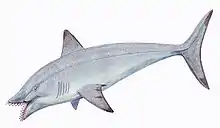

.jpg.webp)
